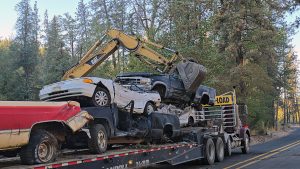For over a decade, employees of the Columbia River Inter-Tribal Fish Commission have brought gifts to families living at in-lieu fishing sites along the Columbia River.
By NIKA BARTOO-SMITH, Underscore News + ICT
For 11 years, Officer Jerrod Daniel has delivered gifts to children living at tribal fishing sites along the Columbia River. For some children there, Salmon Claus delivers the only Christmas gifts they receive. Members of the public can donate in-person to the program through Dec. 16
Congress designated the sites after government engineers flooded and submerged treaty protected fishing sites for the four Columbia River treaty tribes, whose ancestors fished along the river since time immemorial. The government promised to build housing nearly a century ago, but it has only recently begun to do so.
While helping put a smile on people’s faces never gets old, one story in particular stands out for him. During a long day of delivering gifts along the river, Daniel met a young girl, about 8-years-old. He handed her a wrapped present and unlike many of the children around her, she did not open it right away.
When Daniel asked her why, she smiled and said, “I’m going to save it so I have something to open on Christmas.”
Daniel, an officer with the Columbia River Inter-Tribal Police Department, started Project Salmon Claus in 2012, setting out a few donation boxes at the organization’s Hood River office that were quickly filled. Eleven years later, the project has grown to serve hundreds of families living at in-lieu sites along the Columbia River each year.
“We’re serving the community out here on the river and it’s a really important thing to do,” Daniel said.
Project Salmon Claus
When Daniel started Project Salmon Claus in 2012, he knew he wanted to bring gifts to children and families at the in lieu sites up and down the Columbia River. A small operation at first, most of the donations came from other CRITFC police officers. During their limited spare time, Daniel and a crew of his coworkers would don Santa hats and light-up necklaces and bring gifts to families.
With a small crew visiting more than a dozen sites — including Celilo, Maryhill, Lone Pine, Dallesport, Lyle and others — the gift giving took days. But it was always worth it to go to the families, instead of making them travel to a pickup location.
“One of the nice things about Salmon Claus is we are able to get out to families that might not be able to get out to the reservation or in town,” Daniel said. “We’ve made it possible for these families to stay at the sites and wait for us.”
In 2013, the year after Daniel started Project Salmon Claus, the main CRITFC organization got involved through the leadership of Charlie Quaempts, a citizen of the Confederated Tribes of the Umatilla Indian Reservation. Now a commission liaison for CRITFC, Quaempts has worked for the organization for 19 years.
With more hands to wrap and pass out gifts, plus more support for fundraising and collecting donations, Project Salmon Claus is able to give to more families.
“Now, we are able to get it all done in one day and serve hundreds of families,” Daniel said. “I’m seeing the smiles on our staff’s faces and how the Salmon Claus events are impacting them. And that to me is really a good feeling.”
On Dec. 19, volunteers led by Officer Daniel and his coworkers will travel to in-lieu sites up and down the Oregon and Washington side of the Columbia River handing out gifts to children, families and elders.
Sought after donations include:
- Toys for boys and girls age 0-17
- Coloring books with crayons/markers/pens/etc
- Board games
- Puzzles (for kids and adults)
- Blankets for elders, adults, and children
- Winter items (hats, gloves, scarfs, socks)
- Stocking stuffers
- Collect gently used winter items like coats, boots, snow pants, etc.
After the 14th, donations may still be made in person through Dec. 16 at a drop-off location listed below:
Hood River: CRITFC Enforcement office, 4270 Westcliff Drive (business hours Sun-Sat)
Cascade Locks: Brigham Fish Market, 681 Wa Na Pa St (business hours)
Portland: CRITFC main office, 700 NE Multnomah Suite 1200 (business hours M-F)
_____________
About in-lieu and treaty fishing access sites
The creation of Bonneville, The Dalles and John Day dams in the late 1930s flooded traditional fishing villages used by Umatilla, Warm Springs, Yakama and Nez Perce tribal members. The U.S. Army Corps of Engineers built the five original in-lieu sites after the Bonneville Dam went up in 1945, as an attempt to mitigate the impacts of dam construction on treaty protected usual and accustomed fishing sites. Congress authorized the other 26 treaty fishing access sites in 1988 under different legislation.
In 2003, The Columbia River Inter-Tribal Fish Commission (CRITFC) entered into a Self-Determination Act Agreement with the Bureau of Indian Affairs (BIA) to take over operation and maintenance of the 31 sites along both the Oregon and Washington side of the Columbia River, for the exclusive use of tribal fishers from the four CRITFC member tribes. The sites are spread across a 147-mile stretch of river between the Bonneville to McNary dams referred to as Zone 6.
Zone 6, where the 31 sites are located, is an exclusive “treaty Indian commercial fishing area.” That means only tribal fishers from the four Columbia River treaty tribes can commercial fish within the 147-mile area, though non-commercial sport fisheries can also fish there.
The sites are patrolled by CRITFC police – tribal police officers who provide law enforcement along the river as part of the member tribes’ rights to self-governance.
The 31 sites offer a range of amenities for tribal fishers, including boat ramps, fish cleaning tables, drying racks, restrooms and shelters. But Congress never adequately funded construction of housing or other basic services like electricity.
“The authorizing legislation for the in-lieu and treaty fishing access sites essentially required the U.S. Army Corps of Engineers to acquire and develop the sites for treaty fishing and then transfer the facilities to the BIA who was required to operate and maintain the sites,” said Laurie Jordan, policy analyst at CRITFC. “There is a long and complicated history regarding funding.”
In 2018, the Water Resources Development Act required the U.S. Army Corps of Engineers to create housing along the Columbia River for nations whose villages were displaced when The Dalles Dam went up. However, the replacement village options were not acceptable to all of the CRITFC member tribes, according to Molly Prescott, spokeswoman for U.S. Senator Jeff Merkley.
The 2022 Water Resources Development Act (WRDA) expands the plan to also replace villages and fishing sites destroyed by construction of the Bonneville, John Day and McNary Dams. “WRDA ‘22 continues Senator Merkley’s work to require the federal government to finally fulfill its promise to replace tribal housing that was displaced by the creation of the Columbia River dams in the 1950s,” Prescott said. “Conversations between the Army Corps and the tribes remain ongoing.”
Last December, the 2023 Omnibus Bill included $4.5 million for Columbia River in-lieu and treaty fishing access sites.
This includes $1.3 million for fishing sites construction. Looking to fiscal year 2024, if Senate Interior, Environment and Related Agencies Appropriations passes into law, it would include $5.5 million for the sites, plus an additional $1 million for fishing sites construction according to the Office of U.S. Senator Ron Wyden.
Until then, CRITFC provides maintenance and law enforcement at the sites. And Project Salmon Claus brings Christmas to the people living there. “This is a community that has kind of been missed and we want to make sure we can get out to them,” Daniel said.




